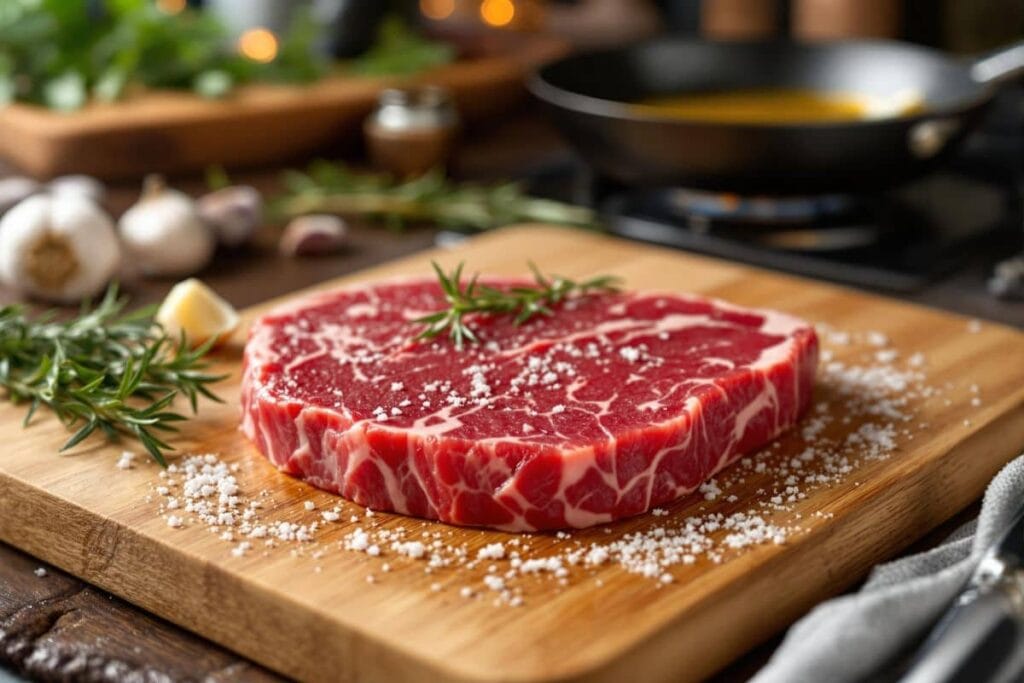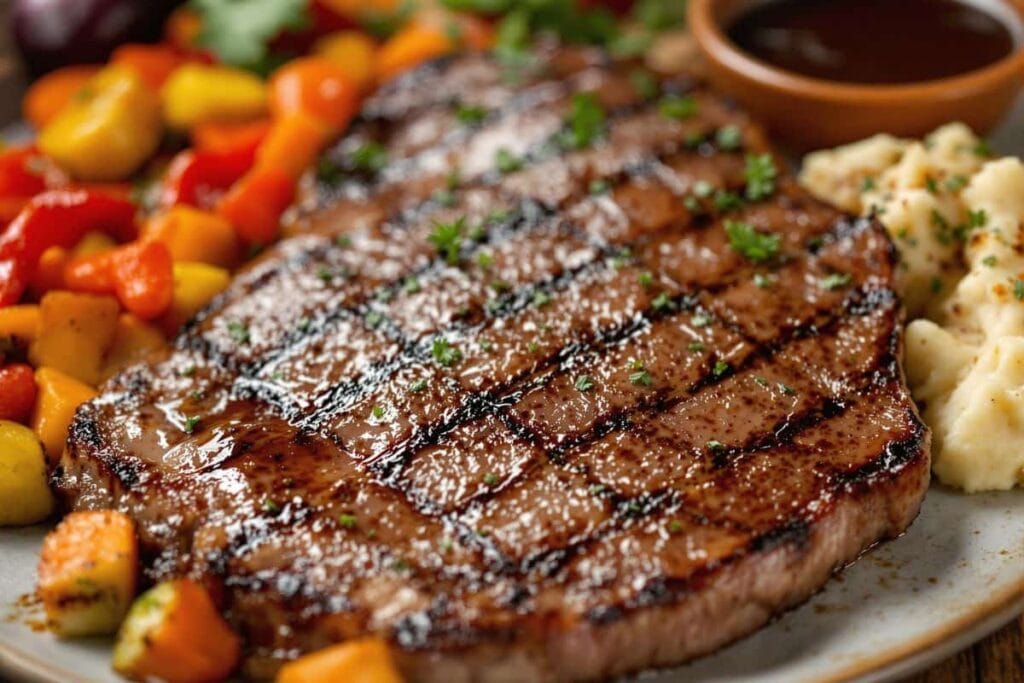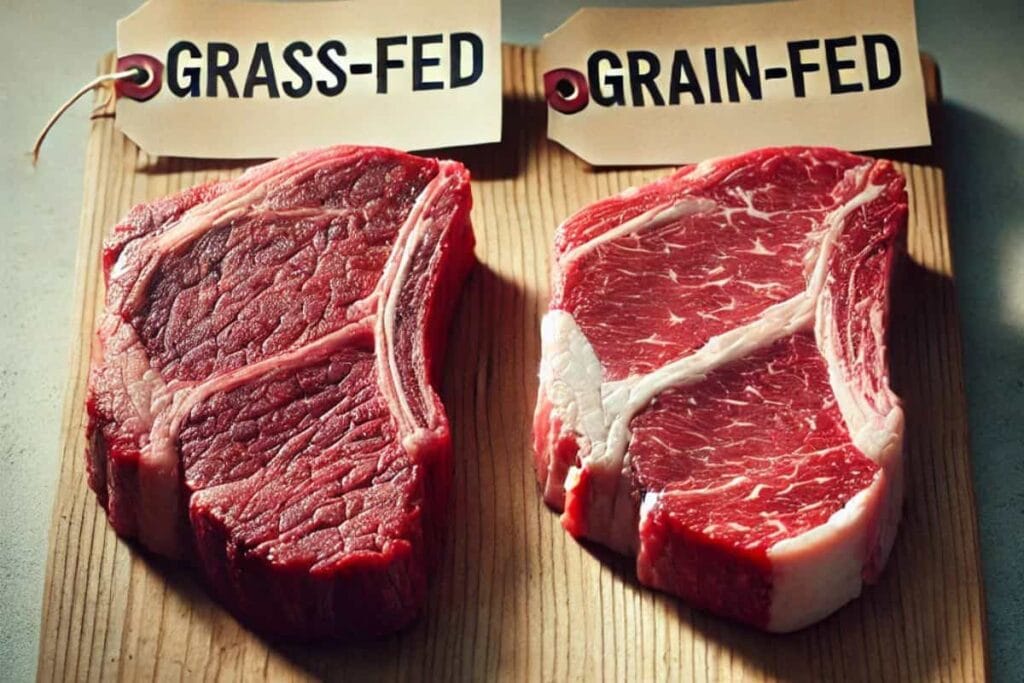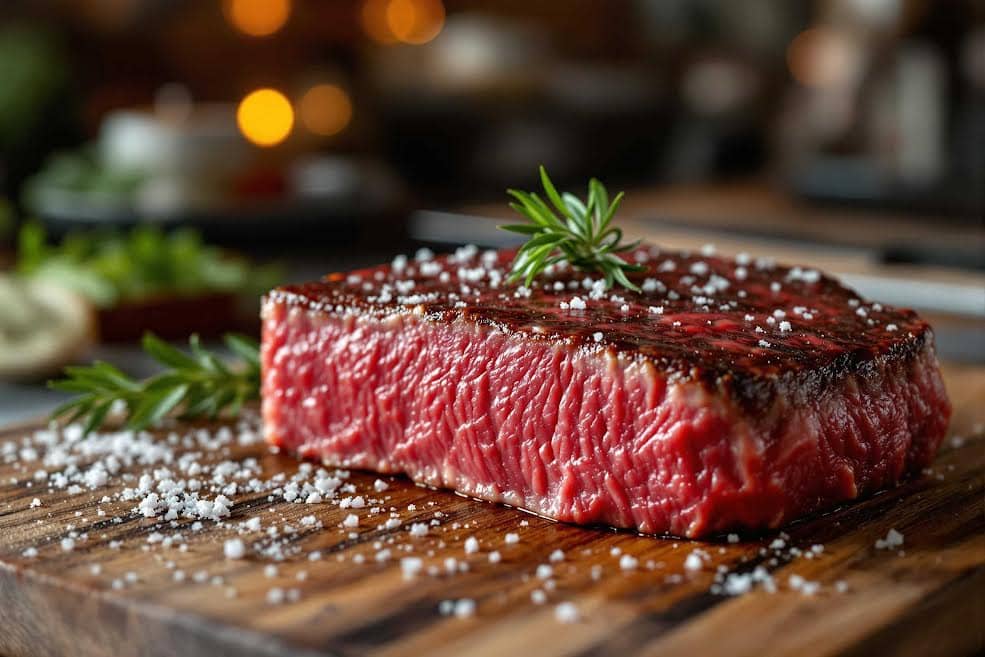Table of contents
What is a Beef Loin Flat Iron Steak?
Let’s start by understanding what a beef loin flat iron steak is. It’s a type of steak that comes from a cow’s shoulder, also known as the chuck. This steak is special because it’s tender (which means soft and easy to chew) and full of flavor. Some people even call it the butcher’s secret because it wasn’t always sold in stores, and butchers used to keep it for themselves!
Flat iron steak is a favorite because:
- It tastes great.
- It’s not as expensive as other fancy cuts like ribeye or filet mignon.
- It’s easy to cook, even if you’re not a chef.
If you’ve ever wanted to make a yummy steak without too much hassle, this is a great choice!
Why is Flat Iron Steak So Popular?
Flat iron steak is getting more and more popular. Why? Well, there are a few reasons:
- It’s affordable: You don’t need to spend a lot of money to enjoy this steak.
- It’s versatile: That means you can cook it in many different ways, like grilling, pan-frying, or even cooking it in water using sous vide.
- It’s flavorful: The natural fat in the meat makes it taste delicious.
- It’s easy to prepare: You don’t need to spend hours in the kitchen.
Also, restaurants have been adding flat iron steak to their menus because people love how it tastes without the high price of other steaks.
Where Does the Flat Iron Steak Come From?
Flat iron steak comes from a part of the cow called the chuck. This is the shoulder area. But even though it’s from the shoulder, it’s not tough like some other cuts. Instead, it’s soft and tender because of where it’s located.
The beef loin, which is another part of the cow, is known for having tender cuts like sirloin and tenderloin. Even though the flat iron steak isn’t directly from the loin, it shares the same tenderness because of how it’s cut and prepared.
How to Choose a High-Quality Flat Iron Steak
When you’re standing in the store looking at steaks, here’s how you can pick the best one:
What Should You Look For?
- Marbling: Marbling is the tiny white streaks of fat in the meat. More marbling means the steak will be juicy and flavorful.
- Color: The meat should look bright red. If it looks brown or dull, it might not be fresh.
- Freshness: Make sure there isn’t too much liquid in the package. Too much liquid can mean the steak isn’t as fresh.
Are There Any Additives?
Sometimes, the label will say if the steak has been injected with solutions to make it juicier. Look for words like:
- “Enhanced with X% solution.”
- “No Additives.”
If you want natural flavor, look for steaks with no additives.
Preparing and Cooking the Beef Loin Flat Iron Steak

Now that you’ve learned about the flat iron steak and how to read the label, let’s move on to how to prepare and cook it. This section will guide you through everything you need to do, from unpacking the steak to serving a delicious meal.
Unpacking and Inspecting the Meat
When you open the package, the first thing you should do is inspect the meat. Here’s what to check:
- Color: The meat should still look bright red. If it has turned brown or gray, it might not be fresh.
- Smell: Fresh steak should have a mild, pleasant smell. If it smells sour or bad, don’t use it.
- Texture: The surface of the steak should be moist but not slimy.
If everything looks good, you’re ready to move to the next step: preparing the steak!
Trimming or Prepping the Steak
Sometimes, the steak might have a bit of fat or silver skin (a tough, shiny layer). You can leave the fat for flavor, but if you see any silver skin, use a sharp knife to carefully trim it off. This will help the steak cook evenly and stay tender.
If the steak is already trimmed and looks clean, you can skip this step. Flat iron steaks are usually sold ready to cook, so you won’t need to do much trimming.
Choosing How to Cook Your Flat Iron Steak
The way you cook your flat iron steak depends on its thickness and your taste preferences. This steak is very versatile, so you can cook it in different ways. Here are three popular methods:
1. Grilling
Grilling is one of the best ways to cook flat iron steak because it adds a smoky flavor.
- Preheat the grill to medium-high heat.
- Cook the steak for 4–5 minutes on each side for medium-rare.
- Use a meat thermometer to check the internal temperature (135°F for medium-rare).
2. Pan-Searing
If you don’t have a grill, you can use a pan to get a nice crust on the steak.
- Heat a heavy skillet (like cast iron) over medium-high heat.
- Add a little oil to the pan.
- Sear the steak for 4–5 minutes on each side.
3. Sous Vide
Sous vide is a method where you cook the steak in a water bath before searing it.
- Set the sous vide machine to 130°F for medium-rare.
- Seal the steak in a vacuum bag and cook it in the water bath for 1–2 hours.
- Finish by searing the steak in a hot pan for 1–2 minutes per side.
Seasoning Your Flat Iron Steak
Flat iron steak has a rich flavor, so it doesn’t need a lot of seasoning. A simple mix of salt, pepper, and garlic powder works great. If you want to get creative, try adding:
- Smoked paprika for a smoky taste.
- Herbs like rosemary or thyme for an earthy flavor.
- Chili powder for a spicy kick.
Season the steak about 15–30 minutes before cooking to let the flavors sink in.
Adjusting Cooking for USDA Grade
Remember those USDA grades we talked about earlier? They can affect how you cook your steak:
- Prime: Has more fat, so it’s forgiving if you cook it a little longer.
- Choice: Best when cooked to medium-rare or medium to stay tender.
- Select: Leaner, so cook it quickly and avoid overcooking.
Knowing the grade helps you get the best results, no matter which cut you choose.
Resting the Steak for Juicy Results
After cooking your steak, don’t slice it right away! Let it rest for about 5–10 minutes. Resting allows the juices inside the meat to redistribute, making each bite juicier. Simply cover the steak with aluminum foil and let it sit on the counter.
Pairing Flat Iron Steak with Sides and Sauces

Flat iron steak pairs beautifully with many sides and sauces. Here are a few ideas to make your meal even better:
Sides
- Mashed Potatoes: Creamy and comforting.
- Grilled Vegetables: Add a smoky, healthy touch.
- Salad: A fresh green salad balances the richness of the steak.
Sauces
- Chimichurri: A zesty mix of parsley, garlic, and olive oil.
- Peppercorn Sauce: Creamy with a spicy kick.
- Garlic Butter: A simple yet flavorful topping.
With these sides and sauces, your flat iron steak meal will feel like a feast.
Storing, Nutritional Facts, and Cultural Uses of the Beef Loin Flat Iron Steak
How to Store Flat Iron Steak Safely
If you’re not planning to cook your flat iron steak right away, storing it properly is essential to keep it fresh. Follow these steps for safe storage:
Refrigeration
- Keep the steak in the coldest part of the fridge.
- Use it within 3–5 days of purchase if it’s fresh.
- If the package is vacuum-sealed, it might last up to 10 days. Check the label for specific details.
Freezing
- Wrap the steak tightly in freezer-safe packaging, like plastic wrap or aluminum foil.
- Place it in a freezer bag and remove as much air as possible to prevent freezer burn.
- Label the bag with the date, so you know when you froze it.
- Flat iron steak can last up to 6 months in the freezer.
Reading Sell-By Dates and Safe Storage Times
The sell-by date on the package tells you when the steak should be sold, but it’s not the same as an expiration date. Here’s what you should know:
- If the steak is kept in the fridge, use it within 2–3 days after the sell-by date.
- If you freeze it before the sell-by date, it will stay good for months.
Remember, always check for signs of spoilage like a bad smell, slimy texture, or discoloration before cooking.
How to Repackage for Long-Term Freezing
If you want to freeze the steak for longer periods, follow these steps:
- Remove it from the original packaging.
- Wrap it tightly in plastic wrap or butcher paper.
- Place it in a heavy-duty freezer bag or vacuum-seal it.
- Write the date on the bag.
This method helps preserve the steak’s flavor and texture for up to 12 months.
Nutritional Information of Flat Iron Steak
Flat iron steak is not only delicious but also packed with nutrients. Here’s a breakdown of what’s in a typical 3-ounce serving:
- Calories: About 180
- Protein: 23 grams (great for building muscle)
- Fat: 9 grams, with about 3.5 grams of saturated fat
- Iron: 2.6 mg (important for healthy blood)
- Zinc: 5 mg (boosts your immune system)
It’s a leaner cut compared to some others, so it’s a healthy option for steak lovers.
Grass-Fed vs. Grain-Fed Beef: What’s the Difference?

When you look at flat iron steak labels, you might see terms like grass-fed or grain-fed. Here’s what they mean:
Grass-Fed Beef
- Cows eat mostly grass throughout their lives.
- The meat is leaner and has a slightly earthy flavor.
- It’s higher in omega-3 fatty acids, which are good for your heart.
Grain-Fed Beef
- Cows are fed grains like corn, especially in the final months before processing.
- The meat is more marbled, which makes it tender and flavorful.
- It’s the more common and affordable option in stores.
Both are excellent, so it depends on your taste and budget.
Flat Iron Steak in Global Cuisines
Flat iron steak isn’t just popular in the United States. It’s used in recipes all around the world. Here are some examples:
- Argentina: Flat iron steak is often served with chimichurri, a tangy herb sauce.
- Korea: It’s used in bulgogi, a dish where the steak is thinly sliced, marinated, and grilled.
- Italy: Italians grill the steak and top it with fresh herbs, olive oil, and lemon juice.
- Mexico: It’s perfect for fajitas, with grilled peppers and onions.
This cut is loved globally because it’s tender and easy to cook in different ways.
Popular Recipes and Serving Ideas
If you’re looking for inspiration, here are a few popular recipes for flat iron steak:
Grilled Flat Iron Steak with Garlic Butter
- Season the steak with salt and pepper.
- Grill it and top it with a simple garlic butter sauce.
Steak Fajitas
- Slice the steak thinly after cooking.
- Serve with sautéed onions, peppers, and tortillas.
Flat Iron Steak Salad
- Slice the steak and place it over a bed of fresh greens.
- Add your favorite veggies, nuts, and a vinaigrette.
Asian-Style Steak
- Marinate the steak in soy sauce, ginger, and garlic.
- Grill or pan-sear for a bold flavor.
Why Flat Iron Steak is Called a “Butcher’s Secret”
For many years, the flat iron steak wasn’t available in stores. Butchers knew how tender and delicious it was, so they often kept it for themselves. That’s why it’s called the butcher’s secret.
Now that it’s widely available, more people are discovering its amazing flavor and versatility.
Frequently Asked Questions (FAQs)
1. How do I know if a flat iron steak is fresh?
Look for a bright red color, no bad smell, and no slimy texture.
2. What’s the best way to cook flat iron steak?
Grilling and pan-searing are the easiest and tastiest methods.
3. How long should I let the steak rest after cooking?
Let it rest for 5–10 minutes to keep it juicy.
4. Can I marinate flat iron steak?
Yes! Marinating adds extra flavor, especially for grilling.
5. How do I avoid overcooking the steak?
Use a meat thermometer and cook to 135°F for medium-rare.
6. Is flat iron steak healthy?
Yes, it’s high in protein and iron, with moderate fat content.
7. Can I freeze flat iron steak?
Absolutely! Wrap it well, and it can last up to 6 months in the freezer.
8. What’s the difference between flat iron and flank steak?
Flat iron is more tender and has more marbling than flank steak.
9. Should I trim the fat before cooking?
You can, but leaving some fat adds flavor during cooking.
10. What side dishes go best with flat iron steak?
Mashed potatoes, grilled vegetables, and fresh salads are perfect choices.
Conclusion: The Perfect Cut for Every Occasion
The beef loin flat iron steak is a truly special cut of meat. It combines tenderness, rich flavor, and versatility, making it an ideal choice for everything from casual weeknight dinners to impressive meals for guests. Whether you’re a grilling enthusiast, a fan of pan-seared perfection, or someone who loves exploring global recipes, the flat iron steak delivers satisfaction every time.
Understanding the label ensures you choose the freshest, highest-quality steak that matches your preferences, whether it’s USDA Prime, grass-fed, or organic. Preparing and cooking it with care—seasoning it just right, cooking to your preferred doneness, and letting it rest—guarantees delicious results.
